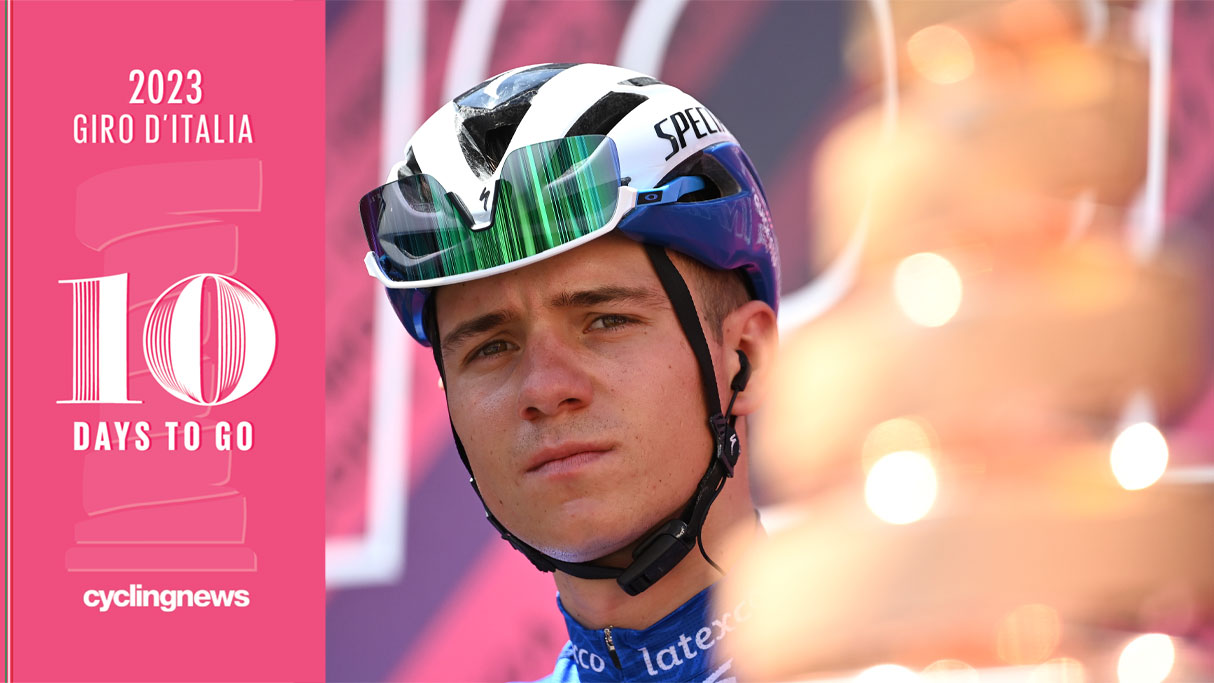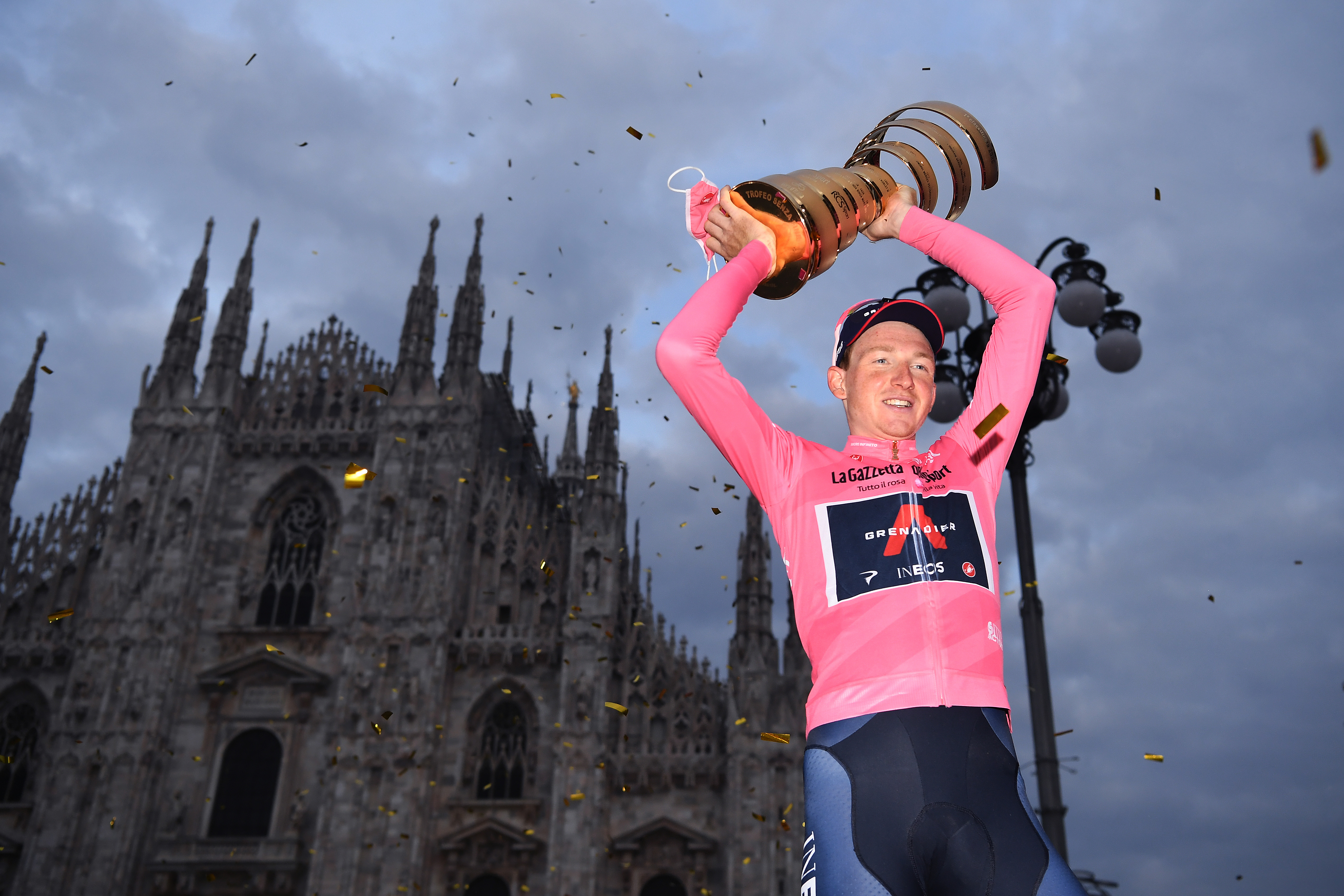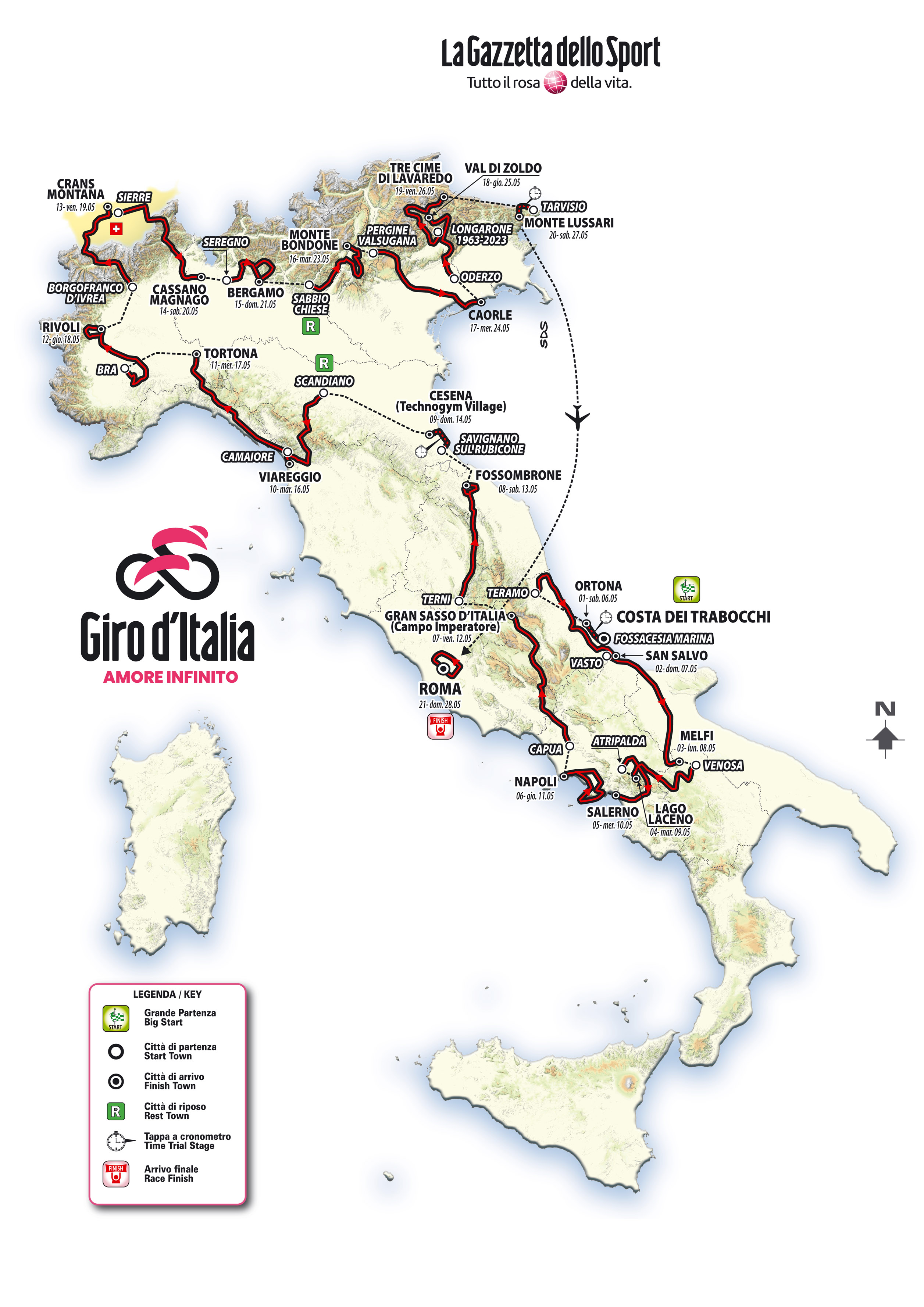
Remco Evenepoel and Primož Roglič must be well used to one another’s company by now. There was already precious little to separate them at the Volta a Catalunya last month and they continued to live in lockstep as they continued their Giro d’Italia preparations at altitude afterwards.
These days, the most exclusive lodging in professional cycling is to be found in the Hotel Parador in Tenerife. There are other options for altitude training, of course, but Mount Teide has long been the outpost of choice, and so the two Giro favourites found themselves taking up residence there at the same time earlier this month.
Every morning, the Soudal-QuickStep and Jumbo-Visma entourages would sit at opposite ends of the dining room before heading out for their day’s work under the volcano. The ritual would repeat itself each evening.
“In the breakfast and dinner room, I had to pass their table to go to my table, so every morning and every evening, it was ‘good morning’ and ‘goodnight,’” Evenepoel smiled last week. “In the day, we didn’t see them a lot, because the training was quite different.”
They will see plenty more of each other out on the road at the 2023 Giro, a race that at this remove has all the appearances of a prize fight between Roglič and Evenepoel, and a reprise of their interrupted contest from last year’s Vuelta a España.
When the Giro d'Italia route was unveiled in Milan in October, the map showed some 70km of time trialling, including two flat tests in the opening week. In other words, it was a route that seemed to double as a come-and-get-me plea to the newly minted world champion Evenepoel.
The Belgian didn’t take long to heed the call, formally confirming the open secret of his Giro participation in November, by which point he was already busily reconnoitering parts of the route. Evenepoel, those close to him say, relishes the methodical steps of a long-term project, and this, his second tilt at the Giro, has been planned along strikingly similar lines to his successful Vuelta a España build-of up last year.
The omens are encouraging. Last summer, Evenepoel took time out of his altitude training to send an ominous pre-Vuelta message at the Clásica San Sebastián, a warning echoed at Liège-Bastogne-Liège on Sunday. Lest there were any doubts, the 23-year-old is on schedule for the Grande Partenza.
But then so too is Roglič, despite rumours to the contrary last winter. The crash that ended the Slovenian’s putative Vuelta fightback in Tomares forced him to undergo shoulder surgery that delayed his pre-season training and raised questions about his planned 2023 programme.
The doubts were quickly assuaged when Roglič won three stages and the overall title in a surprise appearance at Tirreno-Adriatico, and further reassurance came when he withstood Evenepoel’s repeated onslaughts in Catalunya to take the decision there too. There is also plenty in this Giro route for Roglič, not least the mountain time trial on the Italo-Slovenian border on the penultimate day.
Both Evenepoel and Roglič are united, too, by some unfinished business with the Giro. In 2019, Roglič dominated the opening fortnight but then his Jumbo-Visma team made the questionable tactical decision to allow Richard Carapaz significant leeway, distracted by their focus on Vincenzo Nibali. The Ecuadorian gratefully seized the pink jersey and Roglič, restricted by illness in the third week, was never able to win it back, reaching Verona in third overall. No race, least of all the Giro, is ever solely a contest between two riders. Something to ponder ahead of this anticipated duel.
Evenepoel learned lessons of a different kind when he made his Grand Tour debut at the 2021 Giro, which was also his first race after breaking his pelvis eight months previously. In hindsight, it was too much even for a young man of his gifts to process, but for ten days, he convinced himself that he was in the fight for pink before fading as the race drew on.
Both men return to Italy having since proven themselves over three weeks on the Vuelta, and they line up in Pescara on May 6 seemingly on another level to everybody else in the gruppo. As the Volta a Catalunya showed, Roglič tends to have Evenepoel’s number when it comes to sprinting on mountaintops for bonus seconds, but at last year’s Vuelta, his time trialling was no match at all for the younger man’s. Roglič’s Jumbo-Visma team has the greater Grand Tour experience, of course, with Sepp Kuss likely to play a key role, but Evenepoel’s Soudal-QuickStep guard has the feel of a coming force.
It’s hard to separate Roglič and Evenpoel, in other words. But something like 3,451km of racing in all conditions from Abruzzo to Rome ought to do it.

Beyond the expected duel
Yet while all signs point to a two-way tussle for the maglia rosa, the Evenepoel-Roglič contest will not take place in a vacuum. It never does, and cycling history is sprinkled with anticipated duels that never quite materialised in practice; last Sunday’s Liège-Bastogne-Liège was simply the most recent example.
The team most likely to upset the expected duopoly here is Ineos Grenadiers, who came so close to winning a third successive Giro with a third different rider last May. For years during their Team Sky era, their default, defensive mode seemed too rigid for the anarchy of this race, but they’ve got the hang of it in recent seasons – most notably when they adapted to the chaos of the pandemic edition of 2020 better than anybody to help Tao Geoghegan Hart to the maglia rosa.
Geoghegan Hart subsequently seemed to labour under the tag of Giro winner, but the Briton looks to have rediscovered his vim of 2020 in recent months, claiming an assured victory at the Tour of the Alps. Geraint Thomas, meanwhile, is feeling his way into form after a trying start to 2023, and his podium finish at last July’s Tour showed that he can still go the distance over three weeks.
Neither individual has scaled the heights of Roglič or Evenepoel in recent years, but with a supporting cast that includes Pavel Sivakov, Filippo Ganna and Thymen Arensman, Ineos’ collective might will be an important factor on this Giro.
With 2022 winner Jai Hindley opting for the Tour de France, Aleksandr Vlasov leads the line for Bora-Hansgrohe and the Russian’s ability against the watch makes him a most dangerous outsider, while Lennard Kämna also starts with ambition. UAE Team Emirates, meanwhile, also deploy an intriguing double act in João Almeida and Jay Vine. Almeida, 4th in 2020, is ostensibly the leader, but Vine’s progress against the watch since joining the team is striking and the injury that ruined his Spring has not dampened his hopes.
Indeed, leadership tandems or triumvirates are a running theme in this Giro. Jack Haig, Damiano Caruso and Santiago Buitrago headline Bahrain Victorious, while Hugh Carthy and Rigoberto Urán share the reins at EF Education-EasyPost.
Giulio Ciccone (Trek-Segafredo), his recent COVID-19 diagnosis notwithstanding, carries Italian hopes, while Thibaut Pinot (Groupama-FDJ) returns to his favourite Grand Tour in his final season as a professional. Contesting overall victory seems beyond the Frenchman at this point, but his very presence is one of the race’s most compelling narrative threads.
Every day at the Giro brings its own subplot, of course. Some, like the sprint battles of Mark Cavendish and Fernando Gaviria, or Ganna’s time trial mastery, can be predicted in advance. Others are surprises that will reveal themselves as the race unfolds. Such is the beauty of the Giro.
The primo uomo on the final day takes most of the plaudits, but the full story is always told by a chorus of voices.
Read our complete stage-by-stage route guide

A route of two halves
From bust to boom. After last year’s Giro featured the lowest quota of time trial miles since 1963, Mauro Vegni has opted for a considerable correction this time around, with 70km against the watch distributed across three stages. The first two, flat time trials bookend the opening week of the race and the outcome should define the GC hierarchy all the way through the second week to boot.
The Grande Partenza returns to Abruzzo for the first time since 2001 and the 19.6km time trial along the Ciclovia Adriatica on the opening day has the potential to provoke significant early gaps, not least with the uphill finale in Ortona. After a brace of sprint opportunities, the GC men will again be tested on the summit finish at Lago Laceno on stage 4, where Domenico Pozzovivo took the honours in 2012.
From there, the gruppo begins to wind its way northwards, including another, welcome visit to Naples on stage 6. The terrain is not quite as conducive to attackers as last year’s breathless circuit race to the west of the city, but the passage around the base of Vesuvius will be a gripping spectacle all the same.
The most demanding stage of the opening phase follows 24 hours later, as the race climbs above 2,000 metres for the first time with a summit finish at Gran Sasso d’Italia, though the climb itself is a reminder that a lot can change in the course of a Giro. Chris Froome’s hopes looked to have extinguished, after all, when the race came this way in 2018.
The next obvious rendezvous is the stage 9 time trial from Savignano sul Rubicone to Cesena. At a similar point on last year’s Vuelta, Evenepoel put almost a minute into Roglič in a time trial of equivalent length, setting himself up to race on the defensive as required from there on. Evenepoel’s ideal scenario would envisage a repeat performance in this 35km test.
In keeping with recent tradition, the second week of the Giro looks set to be a slow-burning one, as the race heads for the mountains by way of Viareggio, Tortona and Rivoli, but the GC battle will ignite all over again when the race enters the Alps on stage 13, which features some 5,100m of climbing. The interminable Colle del Gran San Bernardo, at 2,472m the highest point of the race, brings the race into Switzerland ahead of the tough Croix de Coeur and the final haul to Crans-Montana.
Two days later, a miniature Giro di Lombardia brings the curtain down on the final week, with the Valico di Valcava and Roncola Alta among the obstacles on the road to Bergamo. In 2019, a similarly explosive stage to Como proved costly indeed for Roglič. Vigilance is of the essence.

The toughest final week
As ever, however, the most robust examinations of the Giro are shoehorned into the final week, and that is why Bora-Hansgrohe directeur sportif Enrico Gasparotto was keen to couch this as a race of two distinct halves at the presentation last October. While he agreed that the early time trials lent themselves to Evenepoel, he was also adamant that no early deficit was irretrievable given the arduous nature of the final days.
When the action resumes after the last rest day, the gruppo faces five classified climbs and 5,200m of altitude gain on stage 16, which finishes at Monte Bondone, forever enshrined in Giro lore as the site of Charly Gaul’s snow-swept exploits in 1956.
There is some respite when the race drops to sea level in Caorle, but three successive days in the high mountains will ultimately decide the destination of the maglia rosa. If the short but sharp stage to Val di Zoldo, with its two-part finishing climb, doesn’t make the difference, then the next day’s colossal tappone through the Dolomites surely will.
Stage 19 features some 5,400m of climbing spread across five ascents. After the passes of the Campolongo, Valparola, Giau and Tre Croci, the race heads for an evocative summit finish at Tre Cime di Lavaredo. In 1968, the mountain marked the moment Eddy Merckx’s reign began in earnest. For Evenepoel, the echo of history seems unavoidable.
The hardship doesn’t end there, of course. On the penultimate day of the Giro, the race heads towards the Slovenian border for an 18.6km test up Monte Lussari. Roglič won’t want for support and, for better or for worse, he knows only too well that a mountain time trial at this juncture can turn everything on its head. “It’s not La Planche des Belles Filles – it’s worse,” Jay Vine told Cyclingnews recently. “If you crack, you could lose two and a half minutes in the final TT alone.”
The Giro is never over until it's over, and the adage is true in every sense this year, with the peloton facing a long transfer south for the final, processional stage in Rome. The decision to finish here rather than in Friuli as originally planned was not without controversy, but the setting is a dramatic one. Whoever ends up being the leading man, the Colosseum offers a suitably cinematic backdrop.







